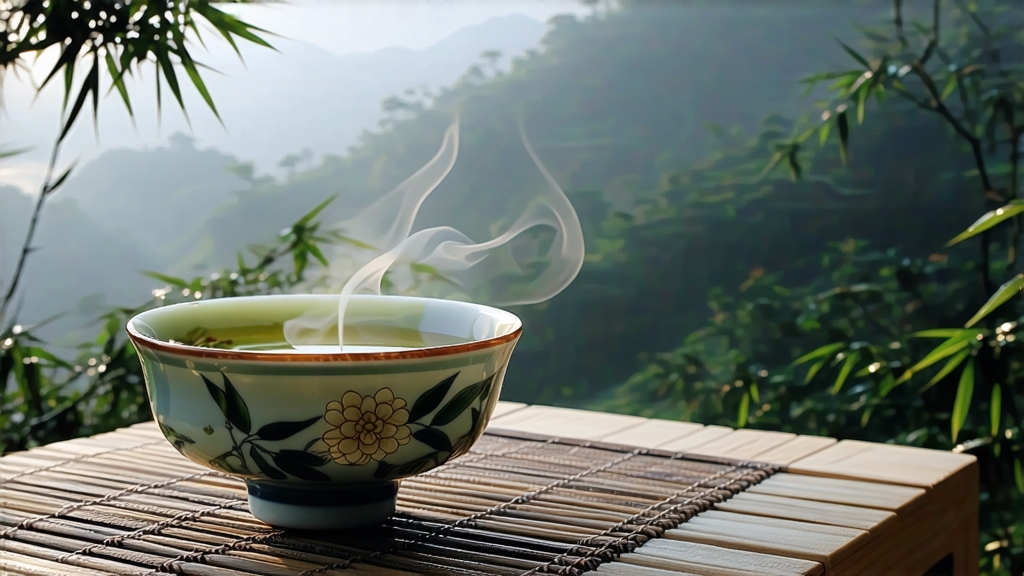
Floating above the Tropic of Cancer, the Alishan range catches moist Pacific air that condenses into a perpetual veil of cloud. It is inside this moving white curtain, between 1,000 and 1,400 m of elevation, that Alishan High-Mountain Oolong (often marketed simply as “Alishan Oolong”) finds its voice. To international drinkers the name may evoke misty peaks and bamboo forests, yet behind the romance lies a cultivar, a craft and a cup that have re-defined what “oolong” can taste like in the twenty-first century.
-
From Seed to Fame: A Brief History
Tea bushes first reached Taiwan’s central mountains in the late eighteenth century, carried across the strait by Fujian settlers who missed their Wuyi rock oolongs. Alishan itself remained a forestry reserve until the 1970s, when a new highway opened the high ridge to itinerant tea traders. Farmers noticed that the Qingxin (Green-heart) cultivar, originally grown for lowland Baozhong, produced intensely fragrant leaves when planted among red cypress and cedar. By 1985 the Taiwan Tea Research and Extension Station had documented higher amino-acid levels at 1,200 m, giving scientific credence to the velvety sweetness cuppers were raving about. In 1999 the devastating 921 earthquake forced rebuilding of mountain villages; aid packages encouraged cooperatives to focus on premium oolong rather than volume, cementing Alishan’s reputation for sustainable, small-batch excellence. -
Cultivar & Terroir: Why Altitude Matters
Alishan Oolong is not tied to a single clone; processors choose Qingxin (TRES #12), Jin Xuan (TRES #12, the “milk oolong” cultivar) or the newer Four-Season Spring. Yet elevation is non-negotiable: the diurnal swing can exceed 15 °C, slowing photosynthesis and stacking leaves with L-theanine and fragrant volatiles. Ultraviolet intensity at 1,200 m is 30 % higher than sea level, prompting the plant to synthesize protective catechins and terpenes that translate into orchid, lily and ripe peach notes. Volcanic shale soils, rich in porphyritic minerals but low in nitrogen, restrain leaf size, yielding the tiny, emerald “dragonfly head” pluck that connoisseurs prize. -
Crafting the Leaf: A 24-Hour Choreography
Harvest begins at dawn during the spring and winter flushes, when two-and-a-half leaves still hold overnight dew. Pickers wear headlamps to finish before 9 a.m.; any later and rising sap increases bitterness. The leaves are then “road-walked” to the factory—often a converted barn smelling of cedar and osmanthus—where the real dance starts:
Step 1: Solar Withering
Bamboo trays are set under a translucent roof for 30–60 min. UV triggers enzymatic activity, softening cellulose and initiating grassy-to-floral conversion.
Step 2: Indoor Withering & Tossing
Leaves are piled 3 cm deep on round rattan trays and gently tossed every hour for 6–10 h. This bruises the edges just enough to release juices while keeping the leaf center intact—crucial for the 20–30 % oxidation target. Masters listen for a rustling “sand-sound” that signals readiness.
Step 3: Fixation
A 260 °C drum roaster halts oxidation in 90 s, locking in a jade-green center ringed with amber—oolong’s signature “green belly with red skirt.”
Step 4: Rolling & Balling
The hot leaves are wrapped in cotton cloth and rolled under mechanical pressure into tight hemispheres. This repeated wrapping–unwrapping (up to 60 cycles) fractures cell walls, allowing oils to migrate to the surface where they will later volatilize in the cup.
Step 5: Drying & Sorting
A 90 °C conveyor oven reduces moisture to 3 %, after which stems and yellow flakes are winnowed by hand. The finished tea rests for 48 h to “settle the fire,” then is vacuum-packed under nitrogen to preserve mountain freshness.
- Tasting the Mountain: Flavor Lexicon
A properly stored Alishan Oolong offers a kaleidoscope that evolves over five infusions:
1